Table of Contents
 Introduction
Introduction
 Select appropriate plants
Select appropriate plants
 Create easy maintenance designs
Create easy maintenance designs
 Leave materials where they fall
Leave materials where they fall
 Move materials to best landscape
use
Move materials to best landscape
use
 Process materials for use
Process materials for use
 Build a compost pile
Build a compost pile
 Give away yard waste
Give away yard waste
 Participate in municipal
composting
Participate in municipal
composting
Every city in America is rapidly running out of landfill space. Fifteen to
twenty percent of solid waste sent to landfills is comprised of leaves, grass
clippings, and other yard wastes. Gardeners can plan their landscapes to produce
less yard waste and use what is produced around their homes to enhance yards,
gardens, and soil. Following are steps gardeners can take towards landscaping
for less in the landfill. They are all effective ways of reducing the amount of
solid waste in our landfills, thereby also reducing the amount, of tax dollars
spent for the landfills.
Return to Table of Contents
-
Avoid planting trees that sprout everywhere (Norway maple), or trees that
produce a lot of yard litter (catalpa).
-
Install the correct size plant for the available space, taking into
consideration the size of the plant after it has matured. Less pruning will be
required.
-
Plant fine-leaved trees and shrubs (serviceberry, dogwood, ash, locust,
sourwood, Japanese zelkova); they produce a minimum of yard waste which breaks
down more quickly than debris from larger-leaved trees.
Return to Table of Contents
Use permanent ground covers (periwinkle, pachysandra, hosta, English ivy,
sedum, bugleweed) instead of lawns or plants that require pruning; this will
reduce mowing and yard waste  accumulation,
as well as water consumption.
accumulation,
as well as water consumption.
Create more decks, paths, or patios to reduce mowing, but not too many as
they can create runoff and possibly erosion.
Understory plantings (shorter plants, such as azaleas and dogwoods, planted
beneath oaks or other larger trees, for example) create a more natural look, as
well as provide an area where leaves can be allowed to accumulate, rather than
being raked or mowed.
Return to Table of Contents
-
Leaves can often be left on the ground, provided they are not deep enough
to smother grass or ground covers underneath. A light layer of leaves can be
shredded by a fall mowing and left on the lawn to decompose and return
nutrients to the soil during the winter.
-
Leave grass clippings on the lawn as mulch to recycle nitrogen. Mow more
frequently so clippings are small and decompose rapidly.
Return to Table of Contents
-
Pine needles make an attractive, exceptionally long lasting mulch. Many
organic mulches, including pine needles and leaves, are especially useful
around acid-loving plants because they may help maintain soil acidity as they
decompose.
-
Brush piles can be located to provide habitat for wildlife. Camouflage
piles by planting attractive vines, such as autumn clematis, to grow over
them.
-
Grass clippings that are too thick to be left on the lawn can be collected
and used as mulch (I to 2 inch layer) on vegetable and fruit plants; however,
don't use clippings from grass that has been treated with an herbicide.
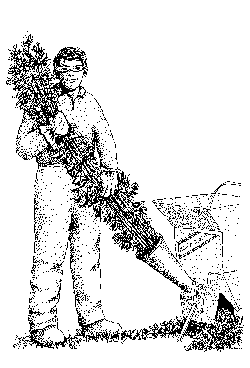
-
Rake leaves and use as mulch (up to 6 inches thick before compaction) to
prevent weeds in the garden. Spread leaves around tree trunks to reduce damage
from lawn mowers.
-
Fill bags with leaves and use as insulation in a cold frame.
-
Till leaves directly into your vegetable garden or annual flower beds to
break down by spring. Because leaf decomposition uses nitrogen from your soil,
you may want to till in manure along with the leaves, or add a small amount of
nitrogen fertilizer to enhance the process.
-
Cover paths between raised beds with leaves in the fall to prevent weed
growth the next spring,
-
Use leaves as a mulch on bare ground to prevent erosion.
Return to Table of Contents
-
Prunings from larger trees and woody plants can be sawed into firewood
lengths.
-
Bark and wood chips created by chipping or shredding branches left over
from pruning make effective, attractive mulches for trees, shrubs, and
pathways.
-
Leaves shredded with a lawn mower, chipper, or shredder can be used as
mulch on beds or around larger plants (2 to 4 inches thick). Shredded leaves
decompose rapidly.
-
Remains of garden plants that are not diseased or insect-infested, such as
com stalks, can be chopped into small pieces (6 to 12 inches long) and used as
a winter mulch in vegetable gardens to control erosion.
Return to Table of Contents
-
Composting can be as simple as a mixed pile of leaves and grass clippings
or as high-tech as a solar powered rotating composter. Both do the job.
-
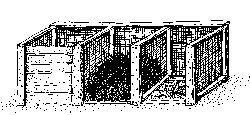 Rake clippings from tall grass to use
in your compost pile. They provide an excellent nitrogen source, especially if
you are without access to manure. If grass is green, however, do not add too
thick a layer of clippings at once, or it will not decompose properly.
Rake clippings from tall grass to use
in your compost pile. They provide an excellent nitrogen source, especially if
you are without access to manure. If grass is green, however, do not add too
thick a layer of clippings at once, or it will not decompose properly.
-
Other lawn wastes - leaves (both dry and fresh), straw, sawdust, woodchips
- provide carbon and nitrogen for compost.
-
Diseased or insect-infested plant parts and weeds should only be composted
if you are certain your compost pile will heat up enough to kill the pest
organisms and weed seeds.
Return to Table of Contents
Find a neighbor who composts and would appreciate your yard wastes. Community
gardens are also often grateful for the organic material.
Return to Table of Contents
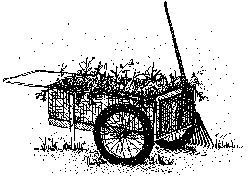 Remember your tax dollars pay the cost
of collecting yard waste and composting; it's cheaper to keep material on your
own property.
Remember your tax dollars pay the cost
of collecting yard waste and composting; it's cheaper to keep material on your
own property.
Return to Table of Contents
![]() Gardeners' Corner
Kids'
Garden
Sustainable Garden
Contact Us
Gardeners' Corner
Kids'
Garden
Sustainable Garden
Contact Us![]()
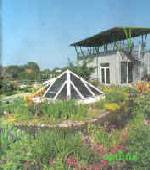

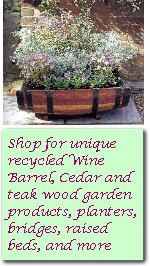
 accumulation,
as well as water consumption.
accumulation,
as well as water consumption. 
 Rake clippings from tall grass to use
in your compost pile. They provide an excellent nitrogen source, especially if
you are without access to manure. If grass is green, however, do not add too
thick a layer of clippings at once, or it will not decompose properly.
Rake clippings from tall grass to use
in your compost pile. They provide an excellent nitrogen source, especially if
you are without access to manure. If grass is green, however, do not add too
thick a layer of clippings at once, or it will not decompose properly.  Remember your tax dollars pay the cost
of collecting yard waste and composting; it's cheaper to keep material on your
own property.
Remember your tax dollars pay the cost
of collecting yard waste and composting; it's cheaper to keep material on your
own property.